Continuing Example 1 Calculate the Following Where All
The critical path method is one of the most important concepts in project management; however, many students have difficulties in its application. In this post, you will learn how to calculate the critical path of a project step by step by following practical examples.

Before you start we recommend you to review our post how to create a PERT CPM chart step by step with examples; where we explain how to graphically represent the relationships between the activities of a project. Creating the chart of project is the starting point to calculate our critical path.
You can also check our online critical path method calculator that performs the steps to calculate the critical path automatically.
What is the Critical Path Method?
The Guide for Project Management (better known as PMBOK Guide), defines the critical path as:
"The sequence of scheduled activities that determines the duration of the project".
To complete a project, we must perform all the activities that compose it. Some activities can be done simultaneously, but others must be done in a certain order. For example, if I am going to build a house, I must first build the walls before painting them. Of all the sequences of activities that make up the project, the sequence that has the longest duration will be the critical path and determines the total project time. As a consequence, the critical path method specifies the algorithm for finding it.
Why is Critical Path Important?
By identifying the critical path, teams recognize the most important tasks to be performed in a project.
Further, any delay in a critical path activity can cause the entire project to be delayed, so managers take extra care to ensure those activities take place as planned.
Important: Projects may have multiple critical paths.
What methods are used to calculate the Critical Path?
The methods used to calculate the critical path are the Project Evaluation and Review Technique (PERT) and the Critical Path Method (CPM).
The PERT and CPM methods began to be developed in the 1950s to assist managers in scheduling, monitoring and controlling large, complex projects. The CPM method (1957) was implemented as a procedure to assist in the construction and maintenance of chemical plants. The PERT technique was developed independently in 1958 for the U.S. Navy's Polaris project.
Although both methods are similar, they used different techniques to estimate task durations. The PERT method used three different time estimates for the duration of each task, plus it calculated the probability of completing the project at a given time. The CPM method used a single duration for each task; however, it also analyzed the additional costs that would be incurred if the project is accelerated.
The differences between the two techniques are now considered to be minimal; therefore, we can refer to both as an overall method called PERT CPM.
How to calculate the critical path?
To calculate the critical path we will follow the following steps:
- Step 1: Obtain the project data. Make a list of all the activities of the project along with their dependencies and their specific times.
- Step 2: Elaborate the network diagram. We have written a post that explains how to elaborate the project network diagram step by step.
- Step 3: Calculate the Early Start and Late Start Times. Determine the Early Start and Late Start Times for each activity.
- Step 4: Calculate the Early Finish and Late Finish Times. Determine the Early Finish and Late Finish Times for each activity.
- Step 5: Calculate the slack time. The critical path must be determined by finding out the slack for each activity of the process. The activities where there is no slack are the ones making up the critical path.
How to Calculate Early Start, Late Start, Early Finish, Late Finish and Slack (Float)
To visualize the calculation of these values, we will use the following graphic representation of the activity:
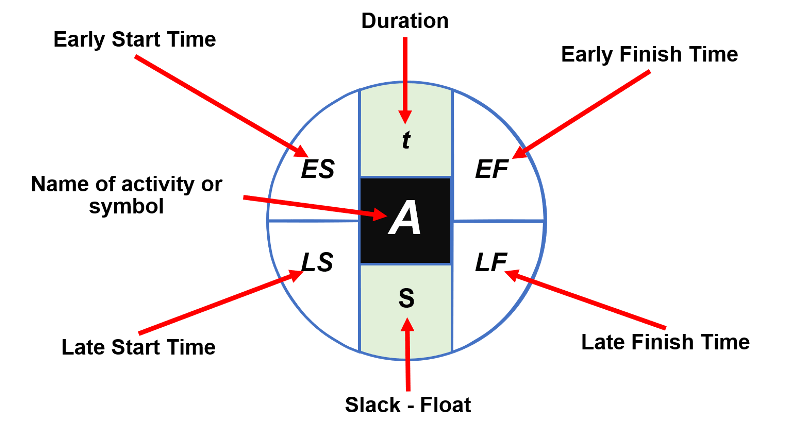
Duration (t):
Indicates the time it takes to complete the activity.
Early Start Time (ES):
This is the earliest time that an activity can be started assuming all previous activities have been completed beforehand. For activities that have more than one precedent, the ES is the greatest of the late start time of their precedents.
Early finish Time (EF):
This is the earliest time that an activity can finish. It is equal to the early start time plus its estimated duration (t):
EF = ES + t
Late Finish Time (LF):
This is the latest time at which an activity can be completed without delaying the entire project. It is obtained by equaling the late start time of the activity that immediately follows. If activities have more than one task immediately following them, the LF will be the least of the late start time of those activities.
Late Start Time (LS):
It is the latest time an activity can begin without delaying the whole project. It is equal to the Late Finish Time minus the expected duration of that activity (t):
LS = LF – t
Slack – Float (S):
A period of time when an activity can be delayed without causing the entire project to be delayed. All activities contained in the critical path have zero slack.
Here is how it is calculated mathematically:
S = LS – ES = LF – EF
We will illustrate these concepts with an example:
Imagine that your professor asks you to write an essay to be submitted in 15 days.
According to the length of the topic, it will take you approximately 1 week to prepare it. If you are a very responsible person, you will probably start the essay as soon as possible. The earliest start time (ES=0) , represents the first moment when you can start your essay:

If you start your project at point 0; you will have it ready at point 7. That final value represents the early finish time (EF=7) .
Now let's suppose that you like to do your activities at the last minute; most likely you want to finish your essay right on the day of the presentation. That day would be point 15 and represents the late finish time (LF=15) . You cannot exceed that point because you will no longer submit the paper on time.

In order for you to finish your paper on the 15th day, you have to start 7 days earlier (the time it takes to do the rehearsal); therefore you must start on the 8th day. This point represents the late start time (LS=8) . If you start after this date you will not be able to submit your work on time.
The 8 free days you have between the time you start work and the date of submission is the slack (float) in your activity.
Slack = LS – ES = LF – EF
Slack = 8 – 0 = 15 – 7 = 8
If we change the scenario and our teacher gives us only the one-week deadline to submit the essay. We will no longer have any free time (slack) so I must start working on the essay from the very beginning to get it done on time. Since this activity has no chance of being delayed, we call it a critical activity.
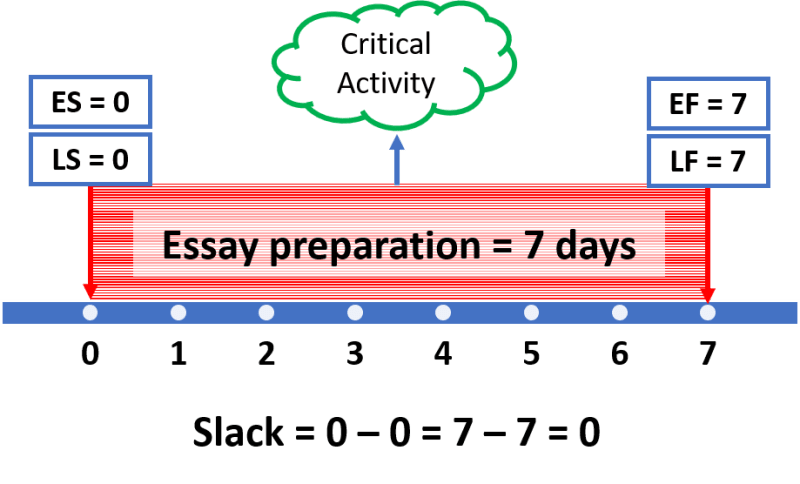
In project management, it is required to calculate these values for each activity which is achieved through a two-path process: a forward path to calculate ES and EF; and a backward path to calculate LS, LF and slack (float).
This procedure will be detailed by means of solved examples:
Example 1:
Draw the activity-on-node (AON) project network associated with the following activities for Dave Carhart's consulting company project.
| Activity | Immediate Predecessor(s) | Time (Days) |
| A | – | 3 |
| B | A | 4 |
| C | A | 6 |
| D | B | 6 |
| E | B | 4 |
| F | C | 4 |
| G | D | 6 |
| H | E, F | 8 |
- How long should it take Dave and his team to complete this project?
- What are the critical path activities?
Solution 1:
The network diagram would look as follows:
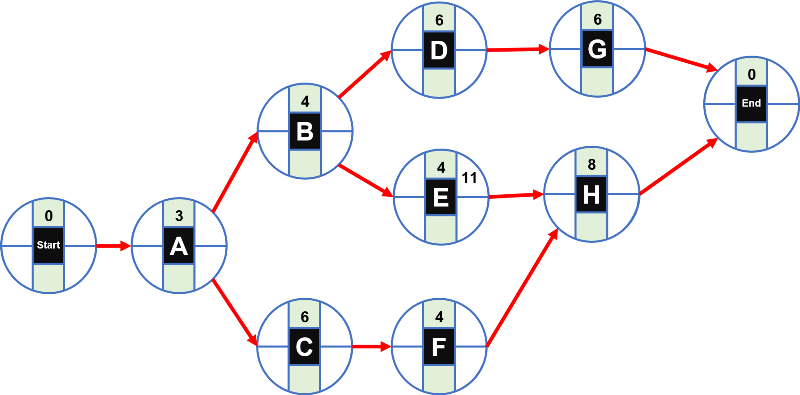
The development of this diagram was explained in detail in our article on creating PERT CPM diagrams. The number at each node represents the duration of each activity.
Forward path
We will now perform the forward path to calculate the ES and EF with an analysis of each activity.
Start node:
This dummy node has all values equal to zero.

Activity A:
Since it is the first activity, its ES will be equal to the EF of the starting node (zero); the EF is calculated as follows:
EF = ES + activity time
EFA = 0 + 3 = 3

Activity B:
It has as precedent only activity A; therefore its ES will be equal to the EF of activity A. In the same way as the previous node, the EF of activity B is calculated by adding its ES + the corresponding time:
EFB = 3 + 4 = 7
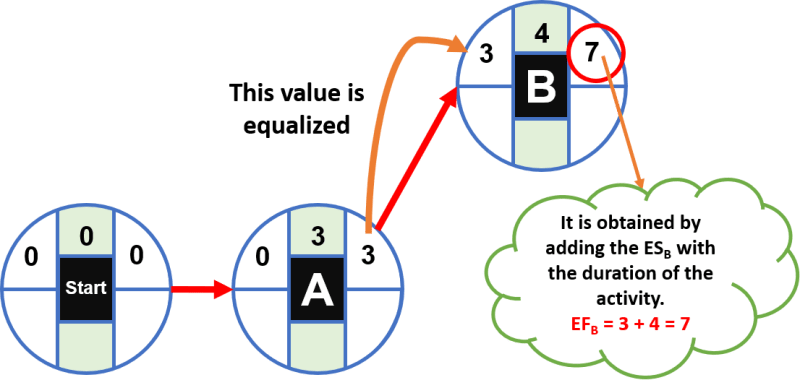
Activity C:
It has as precedent only activity A; therefore its ES will be equal to the EF of activity A. The EF of activity C is calculated by adding its ES + the corresponding time:
EFC = 3 + 6 = 9
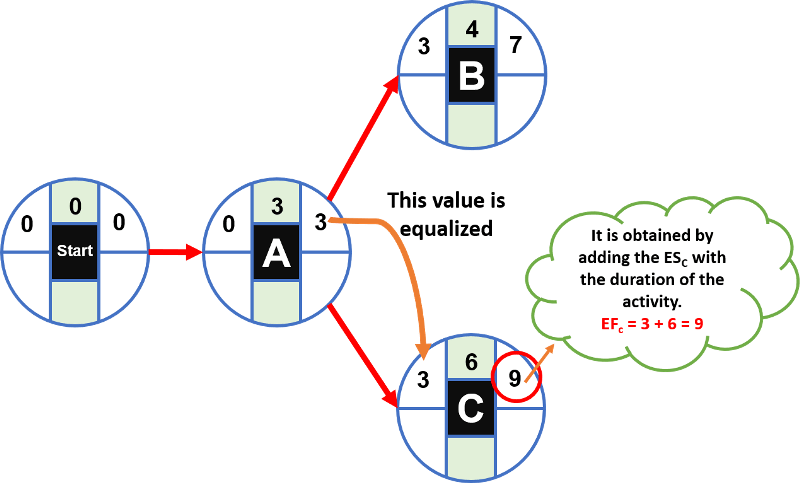
Activity D:
It has as a precedent only activity B; therefore its ES will be equal to the EF of activity B. The EF of activity D is calculated by adding its ES + the corresponding time:
EFD = 7 + 6 = 13
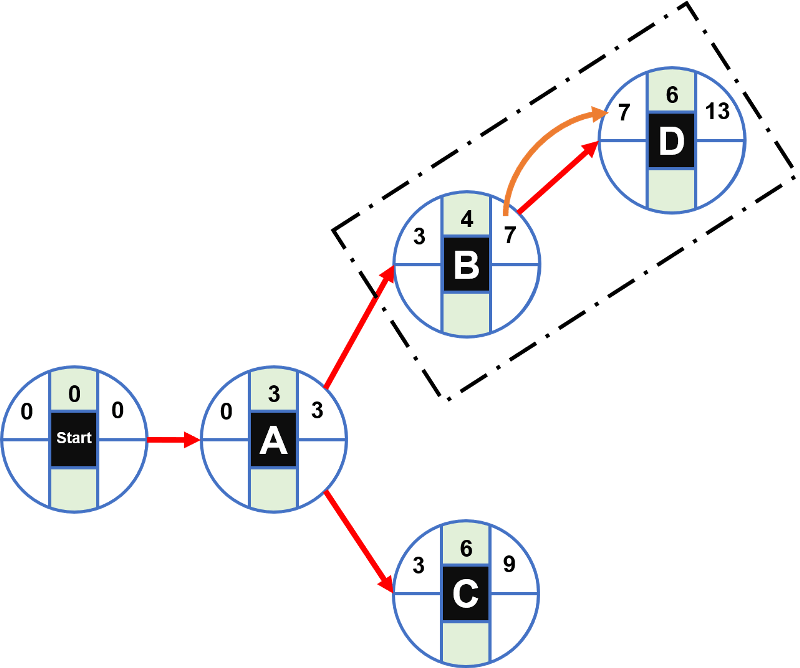
Activity E:
It has as a precedent only activity B; therefore its ES will be equal to the EF of activity B. The EF of activity E is calculated by adding its ES + the corresponding time:
EFE = 7 + 4 = 11
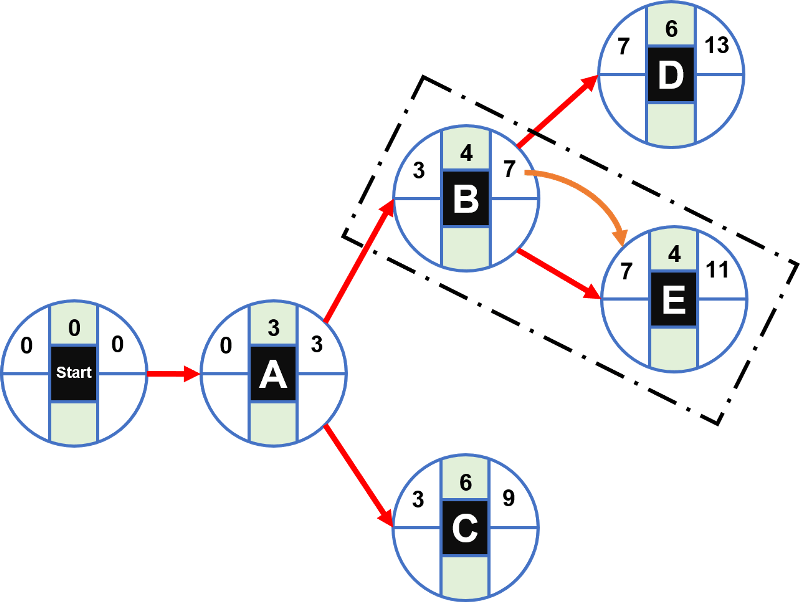
Activity F:
It has as precedent only activity C; therefore its ES will be equal to the EF of activity C. The EF of activity F is calculated by adding its ES + the corresponding time:
EFF = 9 + 4 = 13
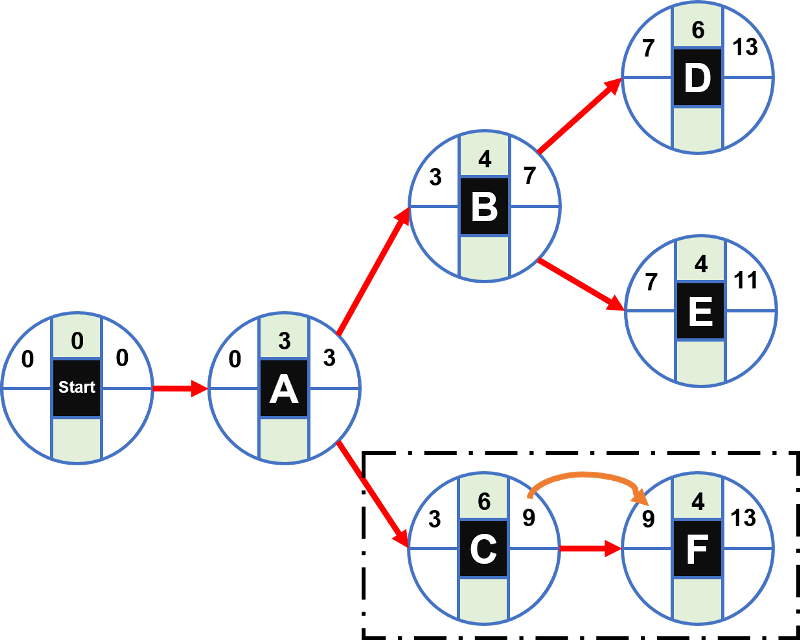
Activity G:
It has as precedent only activity D; therefore its ES will be equal to the EF of activity D. The EF of activity G is calculated by adding its ES + the corresponding time:
EFG = 13 + 6 = 19
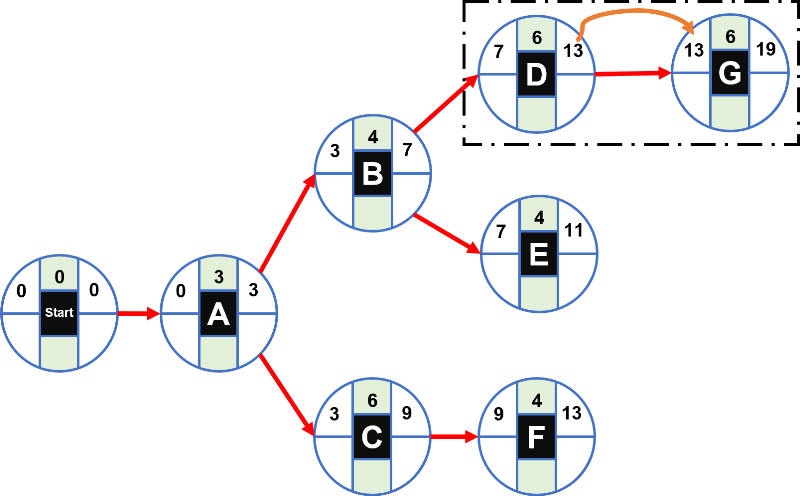
Activity H:
This activity has two precedents: E and F; therefore its ES will be equal to the highest EF of both activities. In this case, activity F has the highest value with 13. The EF of activity H is calculated by adding its ES + the corresponding time:
EFH = 13 + 8 = 21
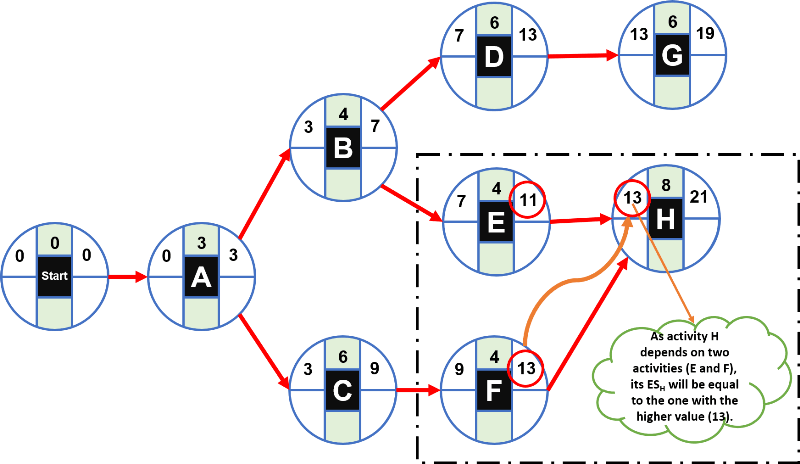
End Node:
The end fictitious node is joined with the last activities G and H; and the highest value of the EF of both activities is placed as ES: 21. This value represents the total duration of the project. As this node has zero duration (because it is fictitious) its EF will be equal to 21 + 0 = 21.
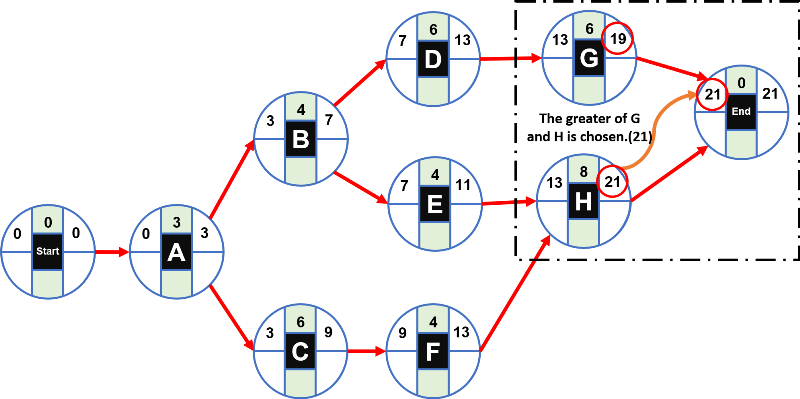
Backward path
To finalize the critical path calculation we will perform the backward traversal to calculate the LF and LS, starting from the final node; placing the values at the bottom of the node as follows:
End Node:
For the end node the LF value is equal to the project duration (21). The LS is calculated by subtracting the LF minus the duration (zero).
LSEnd = 21 – 0 = 21
Activity H:
Since the final node is the only successor to activity H, its LF will be equal to the LS of the final node (21). The LS of activity H is calculated by subtracting its LF minus its duration:
LSH= 21 – 8 = 13
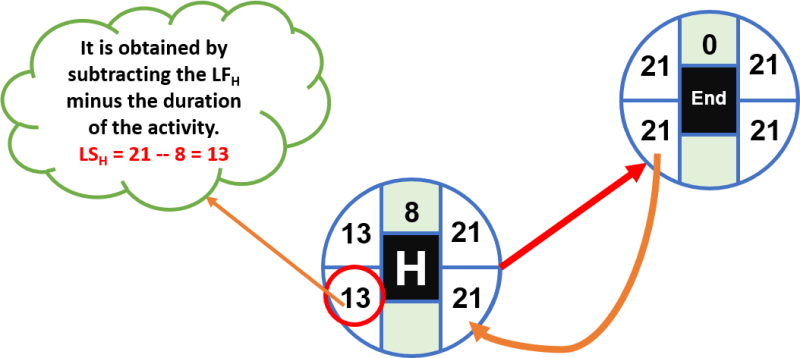
Activity G:
Since the end node is the only successor of activity G, its LF will be equal to the LS of the end node (21). The LS of activity G is calculated by subtracting its LF minus its duration:
LSG = 21 – 6 = 15
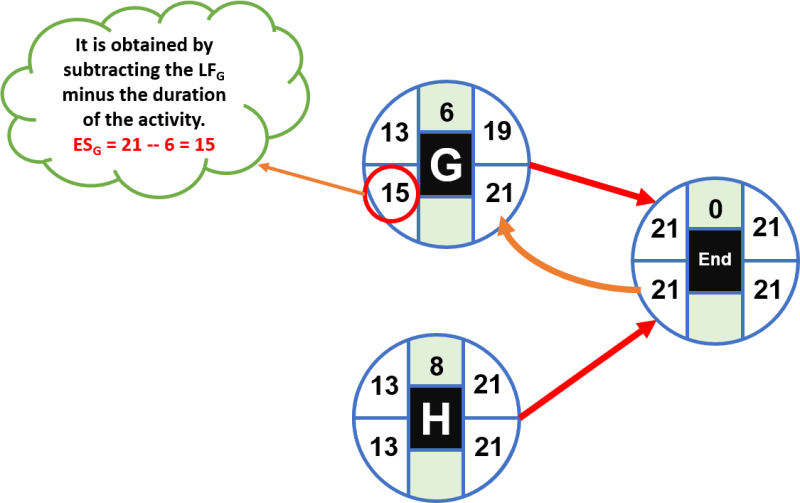
Activity F:
Since activity H is the only successor of activity F, its LF will be equal to the LS of activity H (13). The LS of activity F is calculated by subtracting its LF minus its duration:
LSF = 13 – 4 = 9
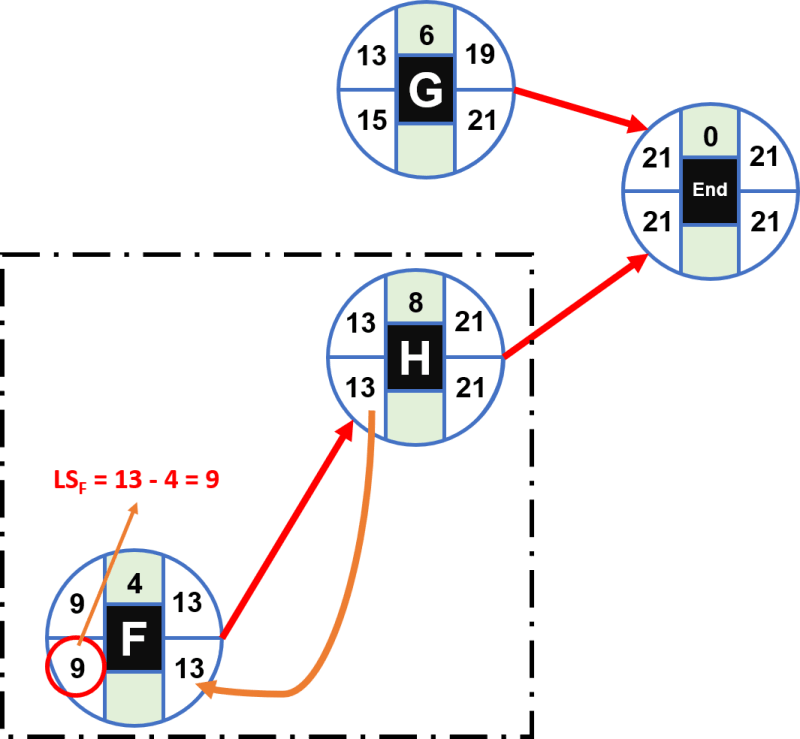
Activity E:
Since activity H is the only successor of activity E, its LF will be equal to the LS of activity H (13). The LS of activity E is calculated by subtracting its LF minus its duration:
LSE = 13 – 4 = 9
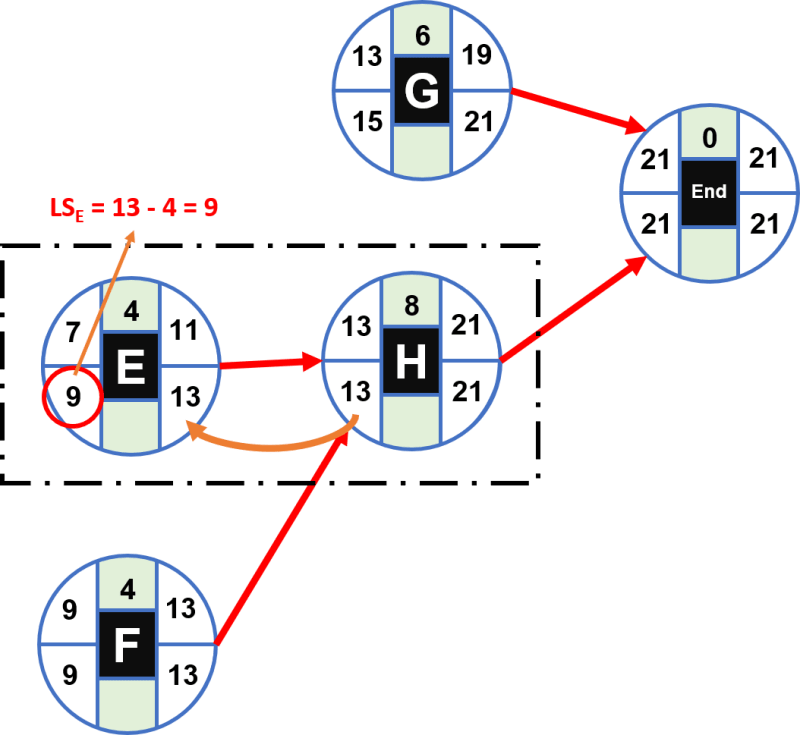
Activity D:
Since activity G is the only successor of activity D, its LF will be equal to the LS of activity G (15). The LS of activity D is calculated by subtracting its LF minus its duration:
LSD = 15 – 6 = 9
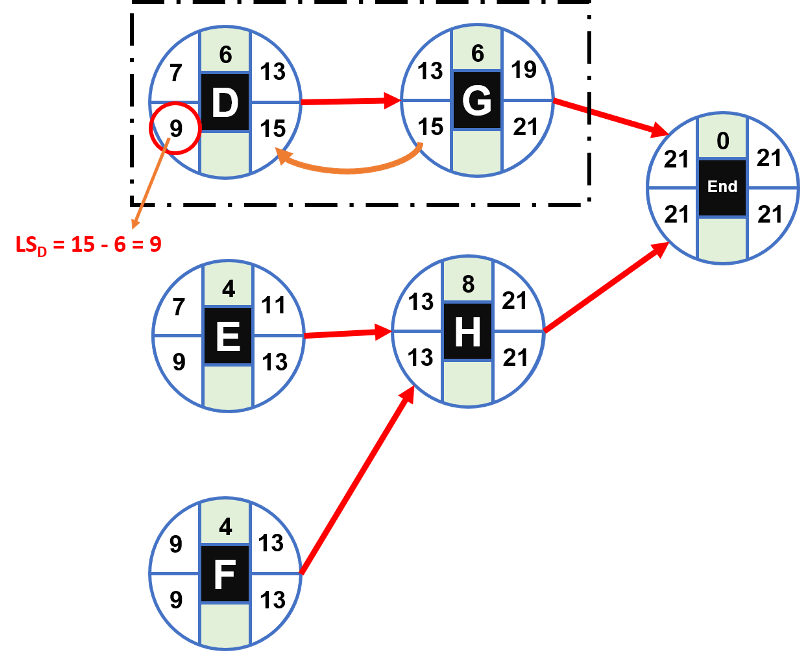
Activity C:
Since activity F is the only successor of activity C, its LF will be equal to the LS of activity F (9). The LS of activity C is calculated by subtracting its LF minus its duration:
LSC = 9 – 6 = 3
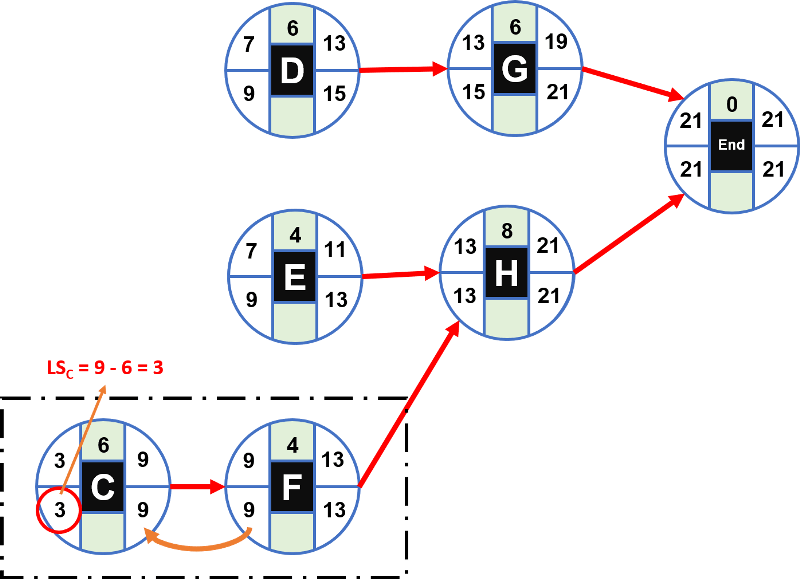
Activity B:
How activity B has as successors activities D and E, its LF will be equal to the smaller value of the LS of both. In this case, since both have a value of 9; that value will be the LF of activity B. The LS of activity B is calculated by subtracting its LF minus its duration:
LSB = 9 – 4 = 5
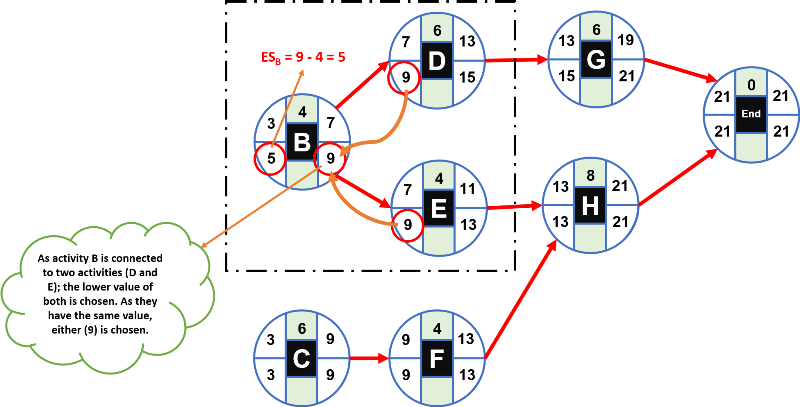
Activity A:
How activity A has as successors activities B and C, its LF will be equal to the smaller value of the LS of both. In this case, the lowest value is that of activity C (3); therefore, that value will be the LF of activity A. The LS of activity A is calculated by subtracting its LF minus its duration:
LSA = 3 – 3 = 0
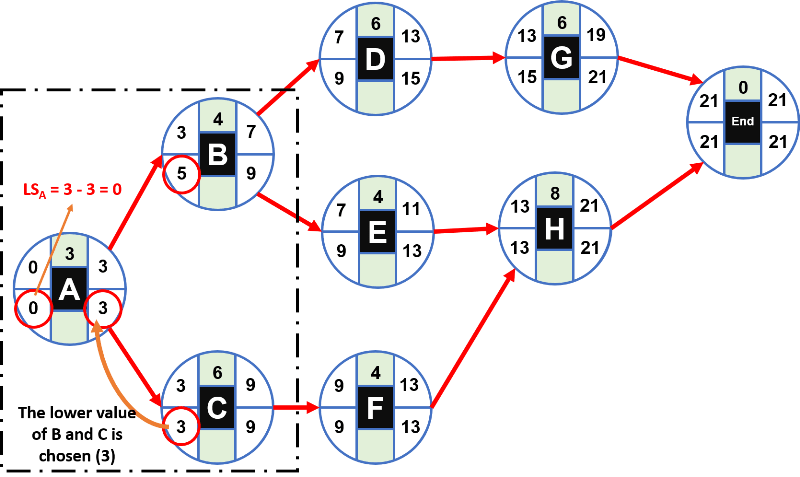
Initial Node:
Using the same analysis as above we complete the values of the initial node with zero.
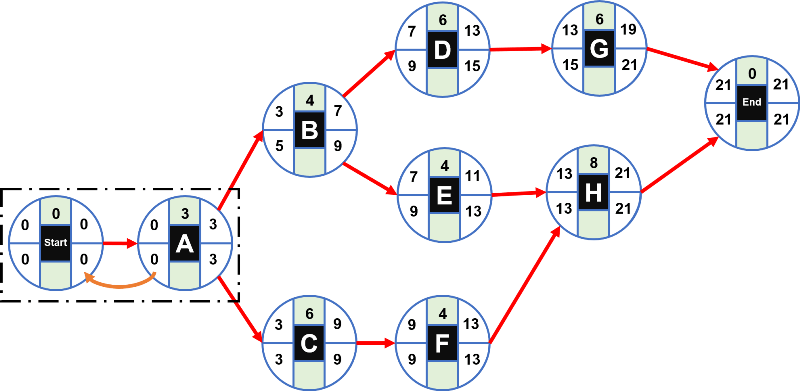
Finally we calculate the slack for each node with the following formula:
Slack = LS – ES = LF – EF
The final graph would look like this:
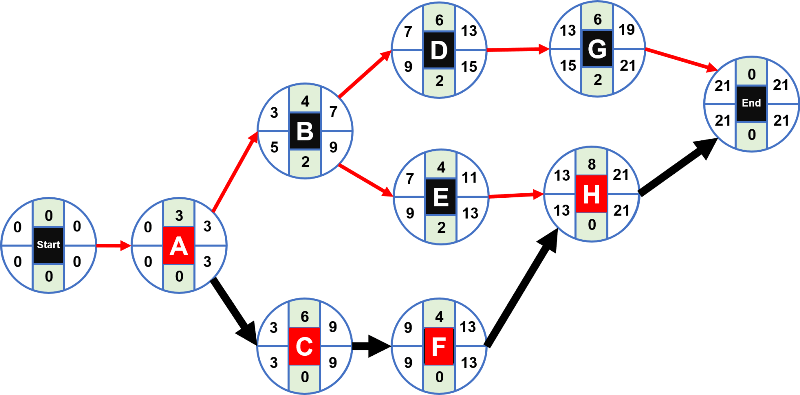
The activities with zero float (marked in red) are the critical activities. In this example, these activities follow a single path that will be our critical path: A – C – F – H. Total project time is 21 days.
Example 2:
Shirley Hopkins is developing a program in leadership training for middle-level managers. Shirley has listed a number of activities that must be completed before a training program of this nature can be conducted. The activities, immediate predecessors, and times appear in the accompanying table.
| Activity | Immediate Predecessor | Time (days) |
| A | – | 2 |
| B | – | 5 |
| C | – | 1 |
| D | B | 10 |
| E | A,D | 3 |
| F | C | 6 |
| G | E,F | 8 |
Provide the following:
- AON diagram for these precedencies
- What is the critical path?
- What is the total project completion date?
- What is the slack time for each individual activity?
Solution 2:
We will solve this example by showing the results and analysis of our critical path method calculator:
Each activity is broken down by its precedents and descendants:
| Predecessor | Activity | Successor |
|---|---|---|
| Start → A | A | A → E |
| Start → B | B | B → D |
| Start → C | C | C → F |
| B → D | D | D → E |
| A → E D → E | E | E → G |
| C → F | F | F → G |
| E → G F → G | G | G → End |
This table serves as a guide to build ournetwork diagram. Two dummy activities were added to show the start and end. The activities with0 (zero) slack are the ones that make up thecritical path.
CPM Network Diagram
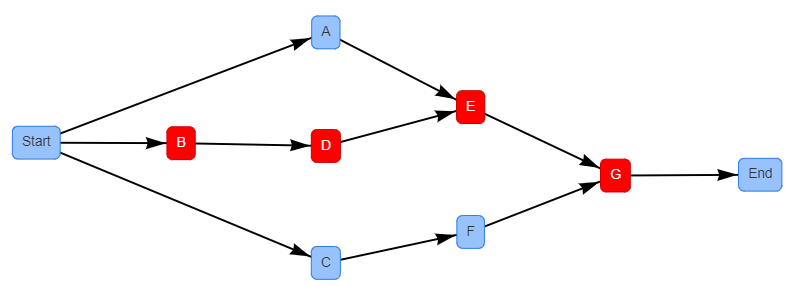
CPM Network Diagram with Calculations of ES, EF, LS, LF and Float
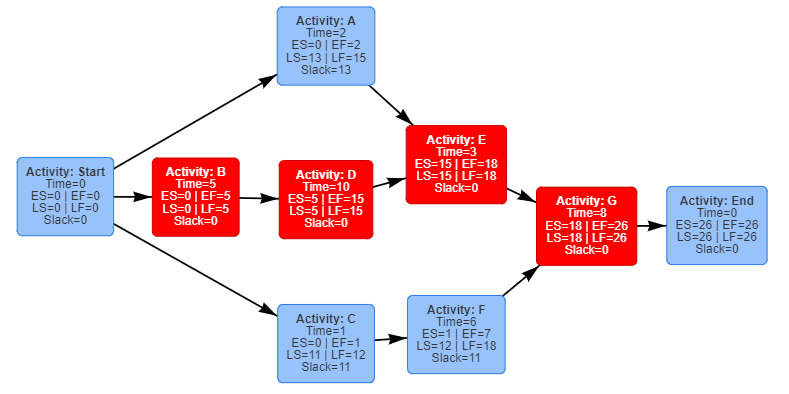
The following table presents the results to determine the critical path:
- Early Start (ES): It is equal to the Early Finish to the activity's precedent. If it has more than one precedent, the highest value is taken.
- Early Finish (EF): It is equal to the Early Start of the activity plus its duration (t). EF = ES + t.
- Late Start (LS): It is equal to the Late Finish minus its duration (t). LS = LF – t.
- Late Finish (LF): It is equal to the late start of the activity that follows. If it has more than one successor, the lowest value is taken.
- Slack (S): It can be calculated in two ways. S = LS – ES = LF – EF. Activities with zero clearance make up the critical path.
| Activity | Time | Early Start (ES) | Early Finish (EF) | Late Start (LS) | Late Finish (LF) | Slack (S) |
|---|---|---|---|---|---|---|
| A | 2 | 0 | 2 | 13 | 15 | 13 |
| B | 5 | 0 | 5 | 0 | 5 | 0 |
| C | 1 | 0 | 1 | 11 | 12 | 11 |
| D | 10 | 5 | 15 | 5 | 15 | 0 |
| E | 3 | 15 | 18 | 15 | 18 | 0 |
| F | 6 | 1 | 7 | 12 | 18 | 11 |
| G | 8 | 18 | 26 | 18 | 26 | 0 |
The critical path is:
B → D → E → G
The total project time is: 26 hours
Final Reflection
The critical path shows us the main activities that will determine the total time of the project; that is why Project Managers must be aware of the fulfillment of each one of them. This does not mean that the other activities should be neglected; on the contrary, if they are delayed longer than their slack, the project will have problems to finish on time.
With the help of our entry, we are confident that you will gain more understanding about the CPM technique and how it can be used to calculate critical path.
Finally, we invite you to follow us on our social networks and join our Facebook group where we can exchange more information with the participants.
Source: https://www.pmcalculators.com/how-to-calculate-the-critical-path/
0 Response to "Continuing Example 1 Calculate the Following Where All"
Post a Comment